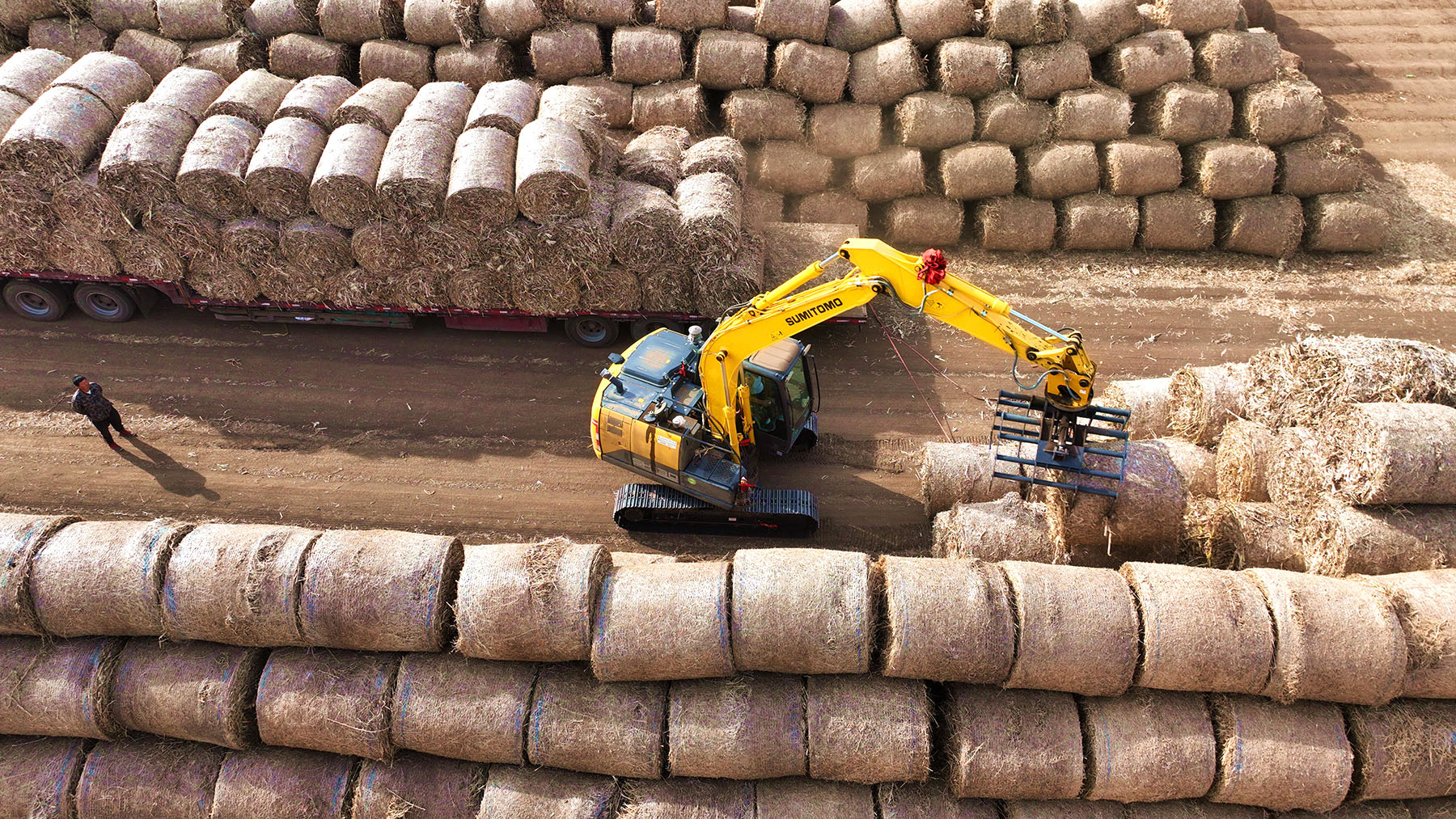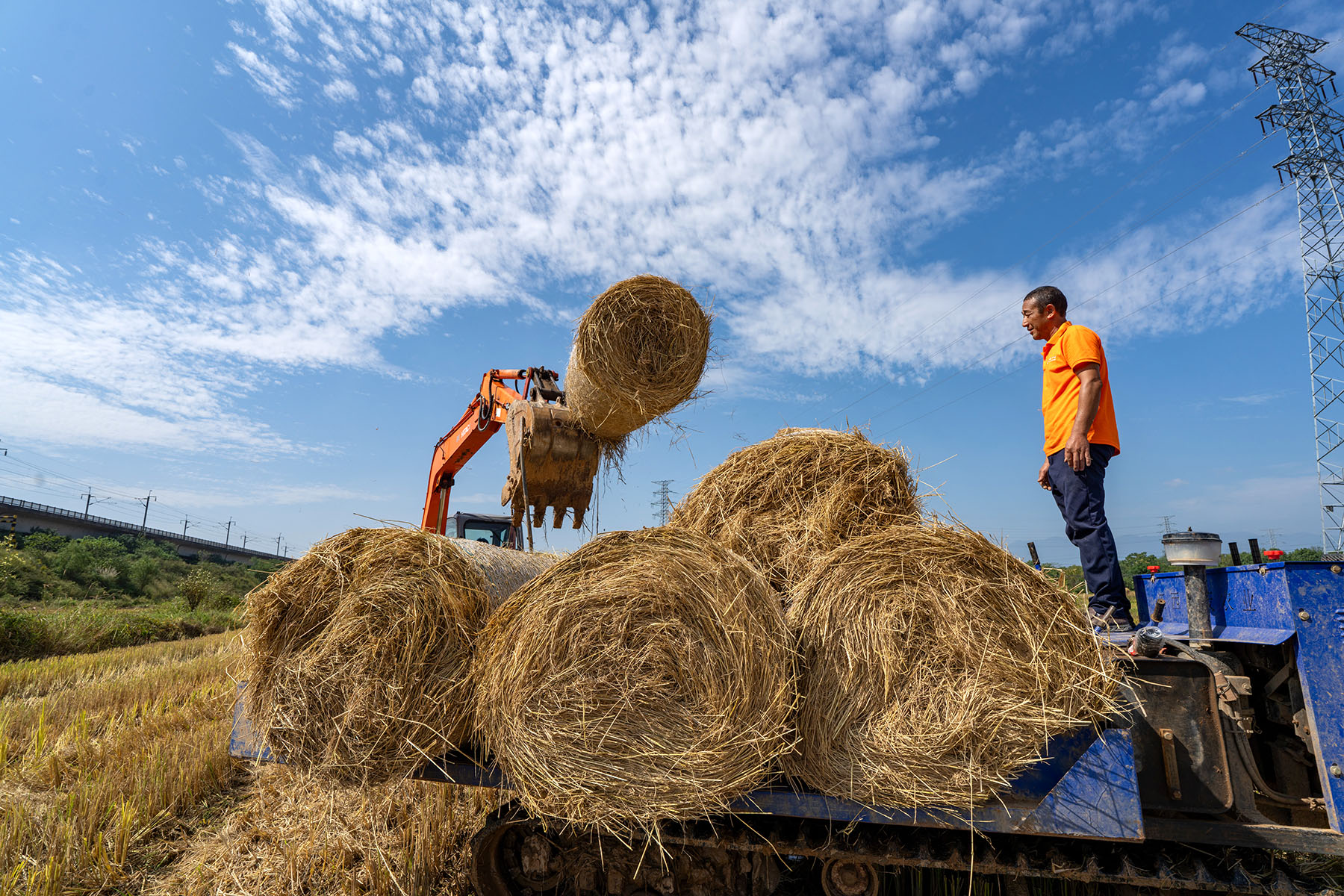Transformation of recycled straw contributes to green transition in grain-growing provinces

Editor's note: China Daily is publishing a series illustrating the country's efforts to achieve its carbon peak and carbon neutrality goals.
Several major grain-producing regions have been proactively leveraging their abundant agricultural and forestry residues to aid the low-carbon transition, converting waste into renewable energy and organic fertilizers.
As the country's largest grain-producing region, Heilongjiang province in Northeast China is developing its bioeconomy, with a focus on producing biogas, according to the Heilongjiang Development and Reform Commission.
In response to inquiries from China Daily, the commission highlighted the significant potential of Heilongjiang in developing biomass energy by utilizing its abundant resources of straw, forestry waste, livestock and poultry manure.
READ MORE: Bioeconomy becomes burgeoning force
According to the commission, the province produces around 90 million metric tons of straw annually, with a potential collection rate of nearly 86 percent. The province's 20 million hectares of forests are estimated to create 9.6 million tons of waste each year. The province's substantial livestock and poultry industry also serves as a reliable, consistent source for biomass energy production, generating 90 million tons of manure annually, it added.
Recognizing the ample available resources, Heilongjiang has identified biogas as a key emerging sector in the development of renewable energy, and has rolled out a slate of measures to maximize its potential.
In 2022, the province unveiled an action plan, pledging to transform the region into a model demonstration base for large-scale biogas development in China's cold north.
According to the plan, Heilongjiang aims to gradually develop mature biogas production technologies suited to the climate characteristics of northern regions by the end of this year, with a series of large-scale biogas demonstration projects completed and put into operation.
By fully utilizing waste from the agriculture, forestry and livestock sectors, the province expects the biogas industry to thrive and become a key emerging sector for renewable energy.
Heilongjiang has encouraged its major livestock farming counties and grain-producing areas to integrate the harmless treatment of livestock and poultry manure with the comprehensive utilization of straw for biogas demonstration projects.
The commission highlighted the establishment of a complete biogas industrial chain as a priority in its work regarding biogas development.

Aside from accelerating the development of key biogas-producing technologies tailored for cold regions like Heilongjiang, the province has also intensified efforts to establish comprehensive systems for raw material collection and biogas consumption, the commission said.
While it provides a much greener alternative for export-oriented enterprises that consume natural gas, biogas has been integrated into urban natural gas networks and is also used for electricity generation and the production of green methanol.
To date, seven biogas production projects have been put into operation in Heilongjiang, the combined annual capacity of which has reached roughly 50 million cubic meters, the commission said. Another six projects with a total annual production capacity of 28 million cubic meters are still under construction.
Once the six projects are completed, the biogas-producing facilities in the province will be able to annually consume 640,000 tons of straw and harmlessly treat 1 million tons of livestock and poultry manure, it said.
The commission said Heilongjiang already boasts several key enterprises with proprietary technologies for biogas production, including Heilongjiang Boneng Green Energy Technology Co.
Boneng plans to establish 30 centers utilizing its dry anaerobic fermentation technology to produce biogas by 2028, according to Shi Hongying, the company's general manager. Each of the centers will have an annual capacity to dispose of 70,000 to 100,000 tons of livestock and poultry manure and 30,000 to 50,000 tons of straw, outputting 4 million cubic meters of biogas.
Shi noted the company's remarkable progress in implementing the plan, saying that 12 of the centers are either already operational or under construction, with another eight in the planning stages.
Shi emphasized that the company's technology creates substantial climate and economic benefits.
Adaptable to the low-temperature environments of cold northern regions, the technology enables continuous production throughout the year in Heilongjiang, she noted.
Using biogas as a raw material, the company also produces bio-methanol through chemical synthesis. "Both the company's biogas and bio-methanol products received the International Sustainability and Carbon Certification for the EU (ISCC EU) in 2024, making it the first green new energy company in China to attain this certification," she said.
Methanol, a key raw material in the chemical industry, is a chemical building block for hundreds of everyday products, including plastics, paints, car parts and construction materials. However, it is currently mainly derived from fossil fuels.
The manager said the residue from the company's biogas production process will be made into organic fertilizer or artificial black soil, which can be used for soil improvement.

Once operational, the company's 30 centers will be able to annually process 2.1 million tons of manure and 1.5 million tons of straw, she said. In addition to reducing carbon dioxide emissions by 3 million tons per year, the company will also capture 180,000 tons of greenhouse gases for industrial use.
Each of the centers can generate an annual revenue of 15 to 18 million yuan ($2.1 to 2.5 million) from producing biogas, based on a natural gas price of 3.8 to 4.5 yuan per cubic meter, she said.
"In recent years, the government has been promoting a shift in energy consumption from coal to natural gas, and the relatively stable price of natural gas has ensured consistent revenue," Shi said.
As one of the 13 major grain-producing regions in China, Hubei province has also been forging ahead with the utilization of waste from its agricultural and livestock sectors for producing biogas and organic fertilizers.
According to the office of the province's leading group for rural energy development, Hubei will allocate 50 million yuan in special funds this year to support 50 villages in areas with well-developed farming and livestock industries to carry out demonstration projects.
In a statement provided to China Daily, the office stressed the initiative as a potential solution to simultaneously address pollution from farming and promote clean energy production. Every year, roughly 38 million tons of straw is generated in Hubei's agricultural sector, and large-scale animal farming operations across the province produce over 72 million tons of manure, it said.
The initiative this year will promote an operation mode that features renewable energy generation, circular economy and industrial development, the office added.
In addition to implementing biogas facilities customized to local conditions, it said the initiative will establish supporting infrastructure to enable the use of by-products from biogas production such as organic fertilizers, promoting the cultivation of organic and pollution-free agricultural and forestry products.
The office also highlighted additional strategies that will be tapped to increase rural incomes, such as selling organic fertilizers and the trading of carbon credits.
The statement outlined plans to introduce a biogas-fueled electricity generation program in these demonstration villages to boost the consumption of renewable energy in agricultural production and rural living.
Even before the demonstration projects this year, in 2017 Hubei rolled out pilot programs in 18 counties for comprehensive utilization of agricultural waste.
That year, Hubei Green Energy Eco-Tech Co launched a demonstration industrial park for large-scale biogas development in Yicheng county's Liushui township, the largest watermelon-producing area in Hubei.
The park processes livestock and poultry manure, straw and spoiled fruits and vegetables to generate biogas and make organic fertilizers.
ALSO READ: China pushes industrial application of biological breeding
Shen Xueli, an executive at the company, said the initiative aims to effectively tackle agricultural pollution while promoting the development of ecological circular agriculture.
The park has the potential to dispose of some 5,000 tons of different types of waste annually, producing roughly 60,000 tons of solid and liquid organic fertilizers, most of which could be supplied to nearby orchards.
Aside from the environmental benefits, the utilization of agricultural waste comes with economic gains for local residents. Liu Chuanhua, a resident in the township whose family of six depend on farming for a living, is keenly aware of that.
Previously, a large amount of rice straw was left on the farm after the harvest season. As the straw is slow to rot, it posed challenges for the plow work, the 60-year-old said. Now, however, straw balers are used to band the straw for selling, with the prices ranging from 350 to 600 yuan per ton.
"Before, straw left in the fields was just waste. Now, it's collected and turned into money," he said.
Contact the writers at houliqiang@chinadaily.com.cn



